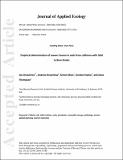Files in this item
Empirical determination of severe trauma in seals from collisions with tidal turbine blades
Item metadata
| dc.contributor.author | Onoufriou, Joe | |
| dc.contributor.author | Brownlow, Andrew | |
| dc.contributor.author | Moss, Simon | |
| dc.contributor.author | Hastie, Gordon | |
| dc.contributor.author | Thompson, Dave | |
| dc.date.accessioned | 2020-05-13T23:34:09Z | |
| dc.date.available | 2020-05-13T23:34:09Z | |
| dc.date.issued | 2019-05-14 | |
| dc.identifier | 258534165 | |
| dc.identifier | 430d0397-6a3f-4d3a-a73b-0d49f3adfbb7 | |
| dc.identifier | 85065794650 | |
| dc.identifier | 000474270200018 | |
| dc.identifier.citation | Onoufriou , J , Brownlow , A , Moss , S , Hastie , G & Thompson , D 2019 , ' Empirical determination of severe trauma in seals from collisions with tidal turbine blades ' , Journal of Applied Ecology , vol. Early View . https://doi.org/10.1111/1365-2664.13388 | en |
| dc.identifier.issn | 0021-8901 | |
| dc.identifier.other | RIS: urn:B4FBA9FE26E547F5DFB1CDCB6B4C84F1 | |
| dc.identifier.other | ORCID: /0000-0003-1546-2876/work/57568155 | |
| dc.identifier.other | ORCID: /0000-0002-9773-2755/work/57568196 | |
| dc.identifier.uri | https://hdl.handle.net/10023/19936 | |
| dc.description | This work was funded by Marine Scotland Science (Marine Mammal Scientific Support Program 2, MRE2). It was also supported by NERC National Capability Funding to the Sea Mammal Research Unit (grant no. SMRU10001). | en |
| dc.description.abstract | 1. Tidal energy converters (turbines) are being developed in many countries as part of attempts to reduce reliance on hydrocarbon fuels. However, the moving blades of tidal turbines pose potential collision risks for marine animals. Accurate assessment of mortality risk as a result of collisions is essential for risk management during planning and consenting processes for marine energy developments. In the absence of information on the physical consequences of such collisions, predicting likely risks relies on theoretical collision risk models. The application of these at a population level usually assumes that all collisions result in mortality. This is unlikely and the approach therefore produces upwardly biased estimates of population consequences. 2. In this study, we estimate the pathological consequences of direct collisions with tidal turbines using seal carcasses and physical models of tidal turbine blades. We quantify severe trauma at a range of impact speeds and to different areas of seal carcasses. A dose–response model was developed with associated uncertainty to determine an impact speed threshold of severe trauma to use in future collision risk models. 3. Results showed that severe trauma was restricted to the thoracic region, with no evidence of injury to the lumbar or cervical spine. Pathological indicators of mortality were only predicted to occur in collision speeds in excess of 5.1 m/s (95% C.I. 3.2–6.6) and was affected by body condition; increasing blubber depth reduced the likelihood of severe trauma. 4. Synthesis and applications. This study provides important information for policy makers and regulators looking to predict the potential impacts of tidal turbines on marine mammals. We demonstrate that the probability of severe trauma in seals due to collisions with turbine blades is highly dependent upon collision speed, and that the majority of predicted collisions are unlikely to cause fatal skeletal trauma. We recommend that collision risk models incorporate appropriate mortality assumptions to ensure accurate estimates of the population consequences are produced in risk assessments for tidal turbine deployments. | |
| dc.format.extent | 13 | |
| dc.format.extent | 1510286 | |
| dc.language.iso | eng | |
| dc.relation.ispartof | Journal of Applied Ecology | en |
| dc.subject | Collision risk | en |
| dc.subject | Marine mammals | en |
| dc.subject | Marine spatial planning | en |
| dc.subject | Pathology | en |
| dc.subject | Pinnipeds | en |
| dc.subject | Renewable energy | en |
| dc.subject | Seals | en |
| dc.subject | Tidal turbines | en |
| dc.subject | GE Environmental Sciences | en |
| dc.subject | QH301 Biology | en |
| dc.subject | DAS | en |
| dc.subject | SDG 7 - Affordable and Clean Energy | en |
| dc.subject | SDG 14 - Life Below Water | en |
| dc.subject.lcc | GE | en |
| dc.subject.lcc | QH301 | en |
| dc.title | Empirical determination of severe trauma in seals from collisions with tidal turbine blades | en |
| dc.type | Journal article | en |
| dc.contributor.sponsor | NERC | en |
| dc.contributor.institution | University of St Andrews. School of Biology | en |
| dc.contributor.institution | University of St Andrews. Sea Mammal Research Unit | en |
| dc.contributor.institution | University of St Andrews. Marine Alliance for Science & Technology Scotland | en |
| dc.contributor.institution | University of St Andrews. Scottish Oceans Institute | en |
| dc.identifier.doi | https://doi.org/10.1111/1365-2664.13388 | |
| dc.description.status | Peer reviewed | en |
| dc.date.embargoedUntil | 2020-05-14 | |
| dc.identifier.grantnumber | Agreement R8-H12-86 | en |
This item appears in the following Collection(s)
Items in the St Andrews Research Repository are protected by copyright, with all rights reserved, unless otherwise indicated.

